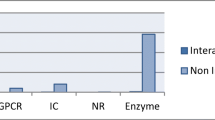Abstract
Prediction of drug–target interactions (DTIs) plays an important role in the drug discovery process. Unfortunately, experimental determination of interactions between drug compounds and target proteins remains a challenging task. Current available heterogeneous data motivate us to develop an effective data integration approach to exploit intrinsic correlations of known interactions between drugs and targets and to predict new interactions. We propose an ensemble learning approach to integrate previously developed methods and to improve the prediction performance. In particular, our algorithm employs a stacking framework, which uses a support vector machine (SVM) classifier as the meta learner to achieve better prediction results.
Access this chapter
Tax calculation will be finalised at checkout
Purchases are for personal use only
Similar content being viewed by others
Notes
- 1.
The dataset can be downloaded from http://web.kuicr.kyoto-u.ac.jp/supp/yoshi/drugtarget/.
References
Yamanishi Y, Kotera M, Kanehisa M, Goto S. Similarity-based machine learning methods for predicting drug–target interactions: a brief review. Brief Bioinform. 2013. doi:10.1093/bib/bbt056, URL: http://bib.oxfordjournals.org/content/early/2013/08/10/bib.bbt056.abstract.
Cheng AC, Coleman RG, Smyth KT, Cao Q, Soulard P, Caffrey DR, et al. Structure-based maximal affinity model predicts small-molecule druggability. Nat Biotechnol. 2007;25(1):71–5.
Morris GM, Huey R, Lindstrom W, Sanner MF, Belew RK, Goodsell DS, et al. AutoDock4 and AutoDockTools4: automated docking with selective receptor flexibility. J Comput Chem. 2009;30(16):2785–91.
Keiser MJ, Roth BL, Armbruster BN, Ernsberger P, Irwin JJ, Shoichet BK. Relating protein pharmacology by ligand chemistry. Nat Biotechnol. 2007;25(2):197–206.
Keiser MJ, Setola V, Irwin JJ, Laggner C, Abbas A I, Hufeisen S J, et al. Predicting new molecular targets for known drugs. Nature. 2009;462(7270):175–81.
Yamanishi Y, Araki M, Gutteridge A, Honda W, Kanehisa M. Prediction of drug–target interaction networks from the integration of chemical and genomic spaces. Bioinformatics. 2008;24(13):i232–40.
Cheng F, Liu C, Jiang J, Lu W, Li W, Liu G, et al. Prediction of drug-target interactions and drug repositioning via network-based inference. PLoS Comput Biol. 2012;8(5):e1002503.
Bleakley K, Yamanishi Y. Supervised prediction of drug–target interactions using bipartite local models. Bioinformatics. 2009;25(18):2397–403.
van Laarhoven T, Nabuurs SB, Marchiori E. Gaussian interaction profile kernels for predicting drug–target interaction. Bioinformatics. 2011;27(21):3036–43.
Zhou ZH. Ensemble methods: foundations and algorithms. Boca Raton, FL: Chapman & Hall/CRC; 2012.
Ishida T, Kinoshita K. Prediction of disordered regions in proteins based on the meta approach. Bioinformatics. 2008;24(11):1344–8.
Bujnicki JM, Elofsson A, Fischer D, Rychlewski L. Structure prediction meta server. Bioinformatics. 2001;17(8):750–1.
Ginalski K, Elofsson A, Fischer D, Rychlewski L. 3D-Jury: a simple approach to improve protein structure predictions. Bioinformatics. 2003;19(8):1015–8.
Wolpert DH. Stacked generalization. Neural Netw. 1992;5(2):241–59.
Freund Y, Schapire RE. A decision-theoretic generalization of on-line learning and an application to boosting. Berlin: Springer; 1995. p. 23–37.
Breiman L. Random forests. Mach Learn. 2001;45(1):5–32.
Xia Z, Wu LY, Zhou X, Wong ST. Semi-supervised drug-protein interaction prediction from heterogeneous biological spaces. BMC Syst Biol. 2010;4 Suppl 2:S6.
Cortes C, Vapnik V. Support-vector networks. Mach Learn. 1995;20(3):273–97.
Chang CC, Lin CJ. LIBSVM: a library for support vector machines. ACM Trans Intell Syst Technol. 2011;2(3):27.
Kanehisa M, Goto S, Hattori M, Aoki-Kinoshita KF, Itoh M, Kawashima S, et al. From genomics to chemical genomics: new developments in KEGG. Nucleic Acids Res. 2006;34 Suppl 1:D354–7.
Schomburg I, Chang A, Ebeling C, Gremse M, Heldt C, Huhn G, et al. BRENDA, the enzyme database: updates and major new developments. Nucleic Acids Res. 2004;32 Suppl 1:D431–3.
Günther S, Kuhn M, Dunkel M, Campillos M, Senger C, Petsalaki E, et al. SuperTarget and matador: resources for exploring drug-target relationships. Nucleic Acids Res. 2008;36 Suppl 1:D919–22.
Knox C, Law V, Jewison T, Liu P, Ly S, Frolkis A, et al. DrugBank 3.0: a comprehensive resource for ‘omics’ research on drugs. Nucleic Acids Res. 2011;39 Suppl 1:D1035–41.
Hattori M, Tanaka N, Kanehisa M, Goto S. SIMCOMP/SUBCOMP: chemical structure search servers for network analyses. Nucleic Acids Res. 2010;38:W652–6. doi:10.1093/nar/gkq367. Web Server issue.
Smith TF, Waterman MS. Identification of common molecular subsequences. J Mol Biol. 1981;147(1):195–7.
Author information
Authors and Affiliations
Corresponding author
Editor information
Editors and Affiliations
Rights and permissions
Copyright information
© 2015 Springer International Publishing Switzerland
About this paper
Cite this paper
Zhang, R. (2015). An Ensemble Learning Approach for Improving Drug–Target Interactions Prediction. In: Wong, W. (eds) Proceedings of the 4th International Conference on Computer Engineering and Networks. Lecture Notes in Electrical Engineering, vol 355. Springer, Cham. https://doi.org/10.1007/978-3-319-11104-9_51
Download citation
DOI: https://doi.org/10.1007/978-3-319-11104-9_51
Publisher Name: Springer, Cham
Print ISBN: 978-3-319-11103-2
Online ISBN: 978-3-319-11104-9
eBook Packages: EngineeringEngineering (R0)




